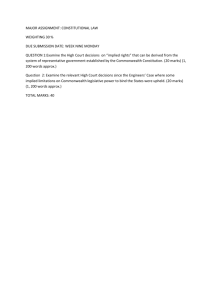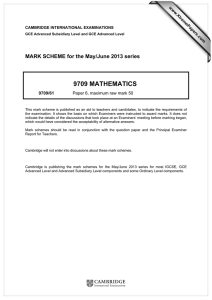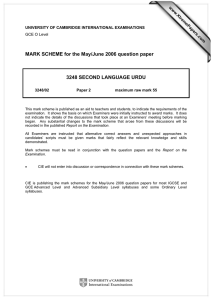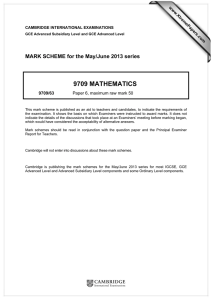9709 MATHEMATICS MARK SCHEME for the May/June 2013 series
advertisement
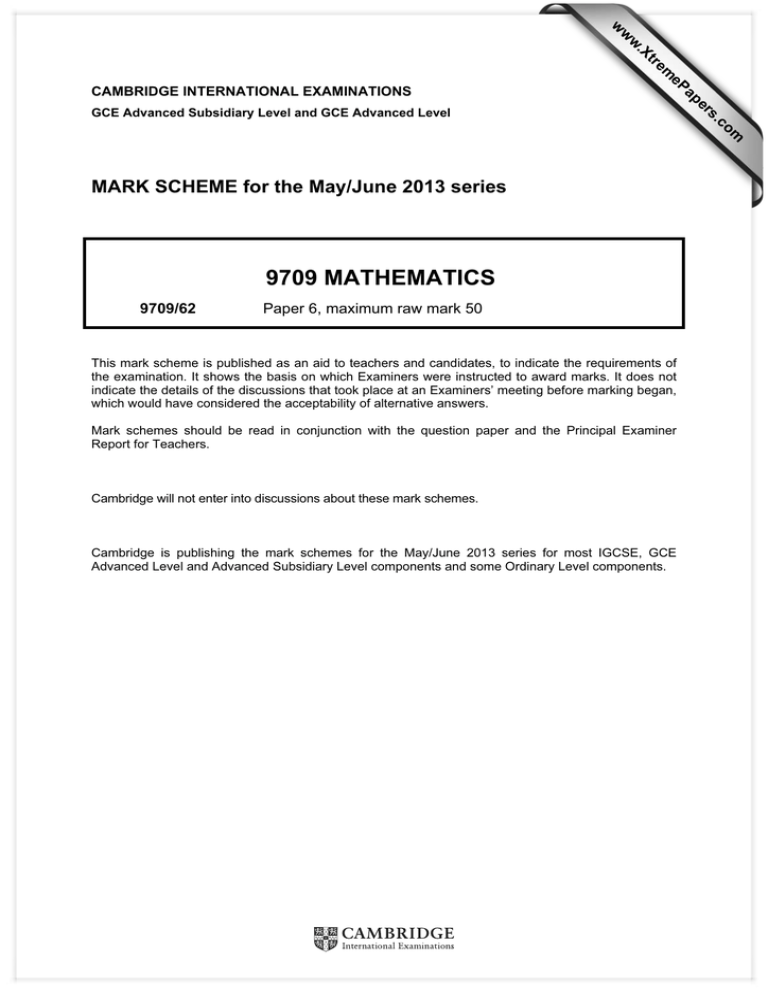
w w ap eP m e tr .X w CAMBRIDGE INTERNATIONAL EXAMINATIONS 9709 MATHEMATICS 9709/62 Paper 6, maximum raw mark 50 This mark scheme is published as an aid to teachers and candidates, to indicate the requirements of the examination. It shows the basis on which Examiners were instructed to award marks. It does not indicate the details of the discussions that took place at an Examiners’ meeting before marking began, which would have considered the acceptability of alternative answers. Mark schemes should be read in conjunction with the question paper and the Principal Examiner Report for Teachers. Cambridge will not enter into discussions about these mark schemes. Cambridge is publishing the mark schemes for the May/June 2013 series for most IGCSE, GCE Advanced Level and Advanced Subsidiary Level components and some Ordinary Level components. om .c MARK SCHEME for the May/June 2013 series s er GCE Advanced Subsidiary Level and GCE Advanced Level Page 2 Mark Scheme GCE AS/A LEVEL – May/June 2013 Syllabus 9709 Paper 62 Mark Scheme Notes Marks are of the following three types: M Method mark, awarded for a valid method applied to the problem. Method marks are not lost for numerical errors, algebraic slips or errors in units. However, it is not usually sufficient for a candidate just to indicate an intention of using some method or just to quote a formula; the formula or idea must be applied to the specific problem in hand, e.g. by substituting the relevant quantities into the formula. Correct application of a formula without the formula being quoted obviously earns the M mark and in some cases an M mark can be implied from a correct answer. A Accuracy mark, awarded for a correct answer or intermediate step correctly obtained. Accuracy marks cannot be given unless the associated method mark is earned (or implied). B Mark for a correct result or statement independent of method marks. • When a part of a question has two or more “method” steps, the M marks are generally independent unless the scheme specifically says otherwise; and similarly when there are several B marks allocated. The notation DM or DB (or dep*) is used to indicate that a particular M or B mark is dependent on an earlier M or B (asterisked) mark in the scheme. When two or more steps are run together by the candidate, the earlier marks are implied and full credit is given. • The symbol implies that the A or B mark indicated is allowed for work correctly following on from previously incorrect results. Otherwise, A or B marks are given for correct work only. A and B marks are not given for fortuitously “correct” answers or results obtained from incorrect working. • Note: B2 or A2 means that the candidate can earn 2 or 0. B2/1/0 means that the candidate can earn anything from 0 to 2. The marks indicated in the scheme may not be subdivided. If there is genuine doubt whether a candidate has earned a mark, allow the candidate the benefit of the doubt. Unless otherwise indicated, marks once gained cannot subsequently be lost, e.g. wrong working following a correct form of answer is ignored. • Wrong or missing units in an answer should not lead to the loss of a mark unless the scheme specifically indicates otherwise. • For a numerical answer, allow the A or B mark if a value is obtained which is correct to 3 s.f., or which would be correct to 3 s.f. if rounded (1 d.p. in the case of an angle). As stated above, an A or B mark is not given if a correct numerical answer arises fortuitously from incorrect working. For Mechanics questions, allow A or B marks for correct answers which arise from taking g equal to 9.8 or 9.81 instead of 10. © Cambridge International Examinations 2013 Page 3 Mark Scheme GCE AS/A LEVEL – May/June 2013 Syllabus 9709 Paper 62 The following abbreviations may be used in a mark scheme or used on the scripts: AEF Any Equivalent Form (of answer is equally acceptable) AG Answer Given on the question paper (so extra checking is needed to ensure that the detailed working leading to the result is valid) BOD Benefit of Doubt (allowed when the validity of a solution may not be absolutely clear) CAO Correct Answer Only (emphasising that no “follow through” from a previous error is allowed) CWO Correct Working Only – often written by a ‘fortuitous’ answer ISW Ignore Subsequent Working MR Misread PA Premature Approximation (resulting in basically correct work that is insufficiently accurate) SOS See Other Solution (the candidate makes a better attempt at the same question) SR Special Ruling (detailing the mark to be given for a specific wrong solution, or a case where some standard marking practice is to be varied in the light of a particular circumstance) Penalties MR –1 A penalty of MR –1 is deducted from A or B marks when the data of a question or part question are genuinely misread and the object and difficulty of the question remain unaltered. In this case all A and B marks then become “follow through ” marks. MR is not applied when the candidate misreads his own figures – this is regarded as an error in accuracy. An MR –2 penalty may be applied in particular cases if agreed at the coordination meeting. PA –1 This is deducted from A or B marks in the case of premature approximation. The PA –1 penalty is usually discussed at the meeting. © Cambridge International Examinations 2013 Page 4 1 Mark Scheme GCE AS/A LEVEL – May/June 2013 z = 1.452 20 − µ 1.452 = µ /5 B1 2 B1 x = 50 + 81.4/22 = 53.7 M1 var = 671/22 – 3.72 = 16.81(16.8) A1 16.81 = Σx2/22 – 53.72 M1 = 63811(63800) 3 A1 rounding to correct answer Attempt to find variance using coding in both, correct formula Correct answer using their var and their mean with uncoded formula for both [4] correct answer M1 M1 Σx2 = 671 + 118140- 55000 = 63811 Var = Σx2/22 – (Σx/22)2 = 16.81 A1 A1 expanded eqn with 22×50 seen expanded eqn with 2 or 3 terms correct correct answer correct answer M1 Standardising no cc no sq or sq rt M1 Correct area (1 – Φ) oe (indep) (i) P( x < 440) 440 − 445 = P z < = 1 - Φ (1.389) 3.6 = 1 – 0.9176 A1 (ii) z = 1.881 c = 1.881 3.6 c = 6.77 (i) [3] OR Σx - 22×50 = 81.4 (Σx = 1181.4) Σx2 -100Σx + 22×502 = 671 Ans = 0.0824 4 Paper 62 Rounding to ± 1.45 20 − µ 20 − 5σ or seen oe µ /5 σ B1 µ = 15.5 Syllabus 9709 = 0.735 Rounding to correct answer accept 0.0825 M1 ±1.88 or 1.881 or 1.882 or 1.555 seen± M1 Equation with ± c/3.6 or 2c/3.6 only = z or prob (can be implied) A1 p = 4/9 or 5/9 P(at least 2) = 1 – P(0, 1) = 1 – (5/9)5 – (4/9)(5/9)4 5C1 [3] [3] Binomial term 5Cxpx(1 – p)5 – x seen B1 M1 A1 Correct answer accept 6.78 [3] Correct answer (ii) np = 96 npq = 32 p = P ( ≤ k) M1 Using np = 96 npq = 32 to obtain eqn in 1 variable p = 2/3 q = 1/3 n = 144 k=6 A1 A1ft 1/3 or 2/3 seen or implied Correct k ft k = 9p n = 144 A1 [4] correct n © Cambridge International Examinations 2013 Page 5 5 Mark Scheme GCE AS/A LEVEL – May/June 2013 Paper 62 (i) Stem leaf 0 1 2 3 4 5 1468 034445556666788 01578 1 5 7 Key 1 4 represents $140 (ii) (iii) Correct stem condone a space under the 1 B1 Correct leaves must be single digits and one line for each stem value or 2 lines each stem value B1ft A1 1.5 × IQ range = 105 M1 Lower outlier is below 35 Upper outlier is above 315 A1ft (i) H 3 4 J O 1. 2 8 7 2 6 2 [3] 2 = 4C2×9C8×2C2 = 54 = 4C3×9C7×2C2 = 144 = 4C4×9C6×2C2 = 84 Total = 282 ways A1 [3] A1 8 J and O trees in 8! = 40320 ways 9 gaps × 8 × 7 × 6 B1 M1 = 121,927,680 (122,000,000) (i) (ii) SR 4C2×9C2×2C2×9C6 SR 4!×6!×2! or 3! or both M1 4!×6!×2! A1 Correct outliers Mult 3 combs, 2C2 may be implied 4Cx×9Cy×2Cz Summing 2 or 3 three-factor options 2 options correct unsimplified [4] Correct answer 4! × 6! × 2! oe seen multiplied by int ≥1 3! seen mult by int ≥ 1 M1 = 207360 (207000) Correct answer cwo Mult their IQ range by 1.5 can be implied Correct limits ft their IQ range and quartiles M1 M1 A1 A1 4! × 6! × 2! × 3! [3] M1 (iii) Correct key must have $, ft 2 special cases Subt their LQ from their UQ M1 Outliers 10, 450, 570 (ii) B1 B1 Median = 160 LQ = 140 UQ = 210 IQ range = UQ - LQ = 70 6 Syllabus 9709 [3] Correct answer 8! seen mult by int ≥ 1 no division 9P4 oe or 7P4 or 8P4 seen mult by int ≥ 1 no division [3] Correct answer M1 M1 © Cambridge International Examinations 2013 Page 6 (iii) SR1 12! – 9! 4! SR2 7 (i) (ii) Mark Scheme GCE AS/A LEVEL – May/June 2013 P(CA) = = x Prob M1 A1 7 4 28 (0.2333) × = 12 10 120 7 4 5 3 43 × + × = (0.3583) 12 10 12 10 120 P(CSCA) = (iii) M1 5 2 1 × = (0.0833) 12 10 12 P (C S ∩ C A ) = P (C ∩ C ) 28 / 120 = 43 / 120 P (C A ) 28 (0.651) 43 0 7/24 1 19/40 2 7/30 5 2 5 5 7 (0.292) × + × = 12 10 12 10 24 P(X = 2) = P(C, C) = 7 4 28 (0.233) × = 12 10 120 P(X = 1) = 1 – 7/24 – 28/120 = 19 (0.475) 40 [2] Mult their P(T) by 2/9 or 2/10 only Correct answer M1 Mult their P(CS) by 3/9 or 4/10 seen as num or denom of a fraction M1 Summing 2 two-factor products to find P(CA) seen anywhere A1 Correct unsimplified P(CA) seen as num or denom of a fraction A1 P(X = 0) = P(T, B) + P(T, T) = Paper 62 M1 9P 4 8! or or both 4! 6! 2! P(T,B) = Syllabus 9709 [4] Correct answer B1 x = 0, 1, 2, can be implied from table or working M1 1 or 2 two-factor products, denoms 12 and 10 or 12 and 9, implied if ans is correct A1 One correct unsimplified B1 One other correct unsimplified B1ft [5] Third correct ft 1 – P(2 of their probs)) © Cambridge International Examinations 2013

